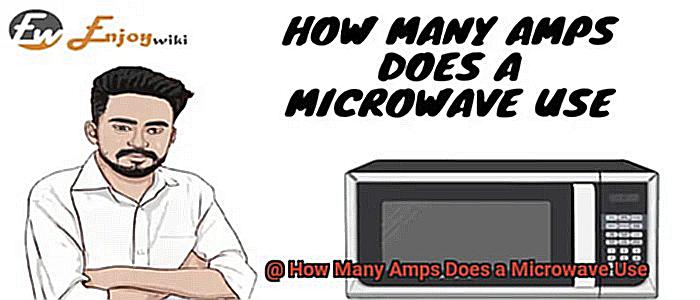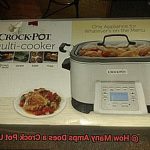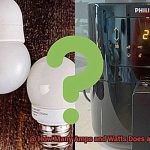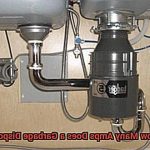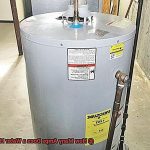Microwaves have revolutionized the way we prepare meals, making it easier and faster to whip up delicious dishes. But have you ever stopped to think about how much energy your microwave is using? How many amps does a microwave use, anyway? And does it consume more electricity than other appliances in your home?
In this blog post, we’ll answer all these questions and more. We’ll take a deep dive into the specifics of how many amps a microwave uses, how it compares to other appliances, and what this means for your monthly electricity bill.
We’ll explore the inner workings of microwaves and why they use the amount of energy they do. Factors like wattage and cooking time can play a big role in energy consumption. And we’ll also look at how your microwave fits into your overall household energy usage, as well as ways you can cut back on energy consumption to save money.
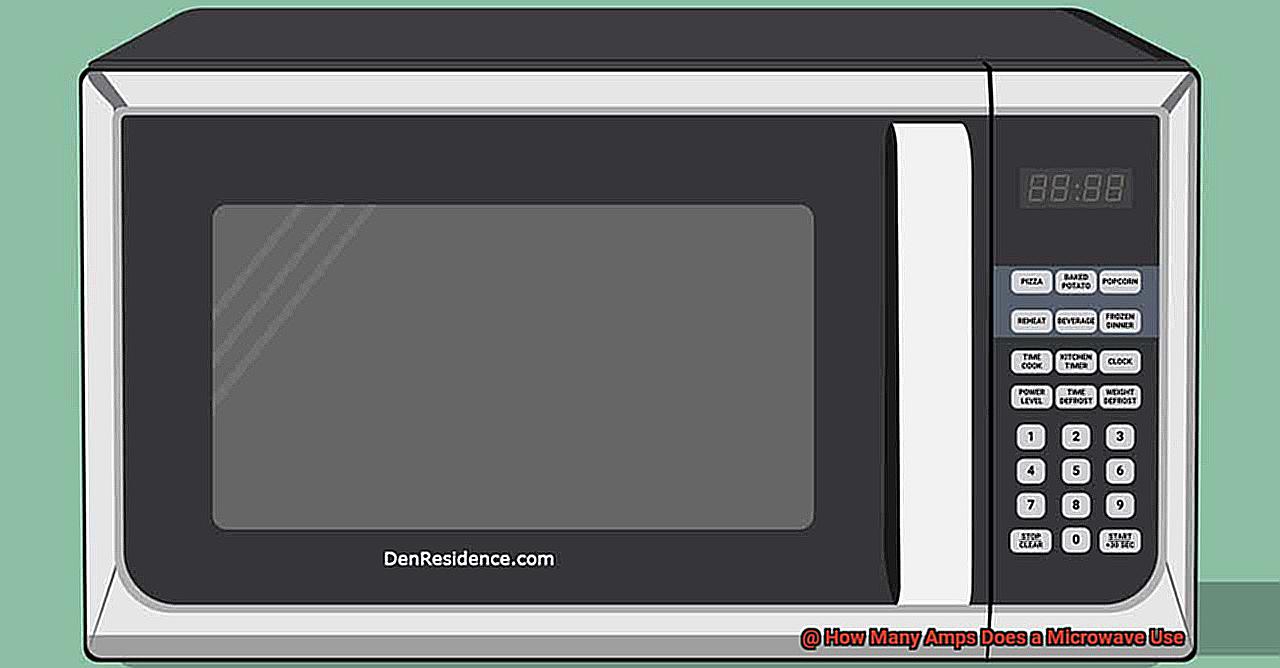
So, if you’re curious about how much power your microwave is really using, keep reading. We’ve got everything you need to know about how many amps a microwave uses.
What is a Microwave?
Contents
Microwaves have revolutionized the way we cook and heat food. From reheating leftovers to cooking a full meal, microwaves have become a staple in households worldwide. But what exactly is a microwave, and how does it work? Let’s dive into the fascinating world of this kitchen appliance.
At its core, a microwave is an electromagnetic radiation device that heats and cooks food quickly and efficiently. This process was discovered by Percy Spencer, who stumbled upon the technology while experimenting with radar systems during World War II.
The waves, which are produced by a device called a magnetron inside the microwave oven, pass through the food item and cause the water molecules within it to vibrate rapidly. This vibration generates heat, which in turn cooks the food.
Microwaves come in various sizes and styles, from small countertop models to larger built-in versions. Most microwaves have a turntable that rotates the food to ensure even cooking. They also have a control panel that allows users to adjust cooking time and power settings.
One of the greatest benefits of microwaves is their incredible speed. With their ability to heat food in just a matter of minutes, they have become an essential appliance in many households. However, it’s important to note that understanding how many amps a microwave uses is crucial for ensuring that your electrical circuits can handle the load.
In conclusion, microwaves are an amazing kitchen appliance that make cooking and heating food quick and easy. Understanding how they work is key to using them effectively and safely.
How Does a Microwave Work?
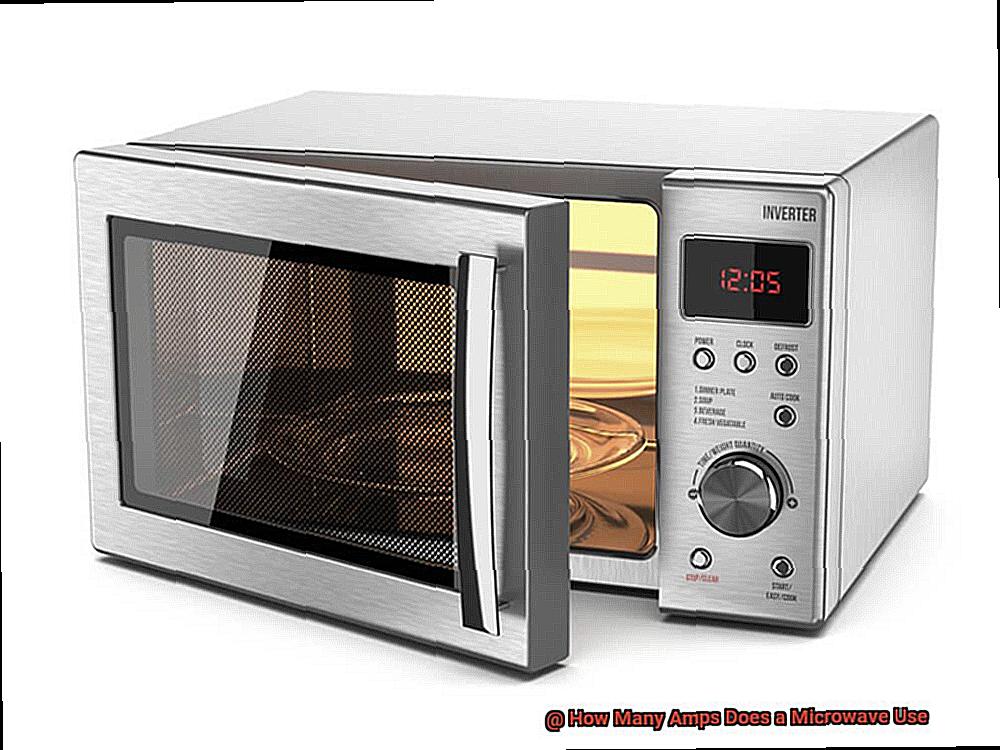
Microwaves are the unsung heroes of our kitchens, saving us from cold leftovers and hungry stomachs. But have you ever wondered how they work their magic? Let me break it down for you in a fun and informative way.
Microwaves use electromagnetic waves, similar to radio waves but with a much shorter wavelength. These waves are generated by a component called a magnetron. When you turn on your microwave, the magnetron springs into action, producing high-frequency radio waves that bounce off the reflective metal walls of the oven and penetrate the food inside.
But how do these waves heat up our food? Well, when they hit the food, they cause the water molecules inside to vibrate rapidly, creating heat. It’s like a dance party inside your dish. And since microwaves directly heat up the water molecules inside the food, they’re incredibly efficient at heating meals in no time.
Now, let’s talk about ensuring even heating throughout your dish. Most microwaves have a turntable that rotates the food while it’s cooking, making sure every corner is heated evenly. But that’s not all – there’s also a fan that circulates hot air inside the oven to ensure uniform heating and cooking throughout your dish.
Microwaves work their magic by generating electromagnetic waves that directly heat up the water molecules inside our food. The result? A piping hot meal in minutes.
How Many Amps Does a Microwave Use?
You probably rely heavily on your trusty microwave. But have you ever stopped to think about how much power it consumes? Don’t worry; we’ve got you covered. Let’s delve into the amperage rating of a microwave and why it’s important to know.
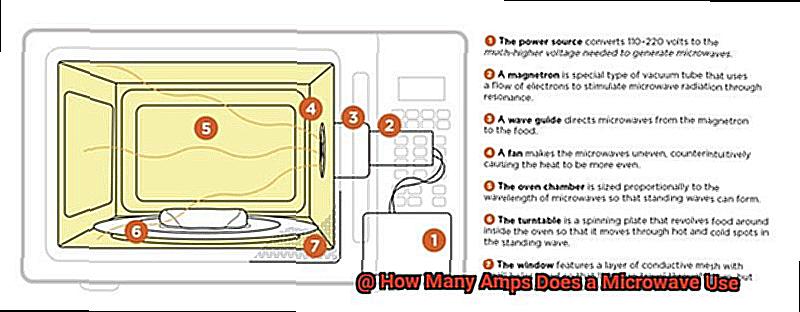
Microwaves come in different sizes and wattages, which can affect their amperage rating. Typically, a microwave uses between 9 to 12 amps, while larger models can go as high as 15 amps.
It’s vital to check the amperage rating before you purchase a microwave to ensure that it doesn’t exceed your home’s electrical circuit capacity.
Overloading your electrical circuits can result in serious issues such as tripped breakers, overheating of wiring, and even electrical fires.
Think of it this way: just as you wouldn’t want to stuff your suitcase beyond capacity and risk it breaking, you wouldn’t want to overload your electrical circuit and risk damaging your home. Your electrical circuit has a limit that you should stay within for safety reasons.
It’s also important to note that running other appliances while using your microwave can cause the amperage to exceed its limit. For instance, if you’re drying your hair or using an air conditioner while cooking with your microwave, it may cause some problems. So be mindful of any other appliances in use when using your microwave.
Factors Affecting the Amount of Amps Used by a Microwave
The wattage of a microwave determines the power it uses to cook your food. The higher the wattage, the faster it cooks your food, but also the more power it consumes. It’s like when you step on the gas pedal in a car – the more horsepower, the more fuel it consumes.
Cooking time is another factor that affects energy consumption. The longer you cook your food, the more amps your microwave will use. So if you’re reheating leftovers or warming up a snack, set the timer for a shorter time to reduce energy usage.
The type of food you’re cooking also plays a role. Frozen foods require more energy to cook than fresh foods because they take longer to heat up and thaw. Think of it like getting warm after coming in from outside on a cold day – it takes longer to get warm than on a warm day.
The age and condition of your microwave can also impact energy consumption. Older models tend to be less efficient and use more energy than newer ones. It’s like comparing running with old shoes versus new ones – you’ll burn more energy with old shoes because they’re not as efficient.
Finally, power settings make a difference. Most microwaves come with different power settings that allow you to adjust the amount of power used for cooking. Using lower power settings will consume less energy than high power settings, much like walking uses less energy than running.
Considerations When Choosing an Electrical Circuit for a Microwave
Before you make a purchase, it’s important to consider the electrical circuit that will power your microwave. Choosing the right circuit is crucial to ensure that your microwave operates safely and efficiently. In this post, we’ll explore some key considerations you need to take into account when choosing an electrical circuit for your microwave.
First, let’s talk about wattage. The wattage of your microwave will determine how many amps it uses. Most microwaves have a wattage between 600 and 1200 watts, which translates to 5 and 10 amps respectively. Knowing the wattage of your microwave is important because you need to choose an electrical circuit that can handle the amps required by your microwave.
The National Electrical Code (NEC) has a safety measure in place that requires each kitchen appliance to be on its own dedicated circuit. This means that your microwave should not share circuits with other kitchen appliances such as your refrigerator or dishwasher. By having a dedicated circuit, you’ll avoid overloading the circuit and causing a potential fire hazard.
In addition to having a dedicated circuit, it’s also important to consider the wiring in your home. If you have older wiring, it may not be able to handle the amps required by your microwave. In this case, you may need to upgrade your wiring or choose a lower wattage microwave. It’s always better to err on the side of caution and choose a lower wattage microwave if you’re unsure about your wiring.
Lastly, take into account other high-wattage appliances in your kitchen. If you plan on using other high-wattage appliances at the same time as your microwave, such as an electric oven or toaster oven, you may need to choose a higher amp circuit to avoid tripping the circuit breaker.
To sum it up, when choosing an electrical circuit for your microwave, remember to consider the wattage of the microwave, choose a dedicated circuit, ensure your wiring can handle the amps required, and consider other high-wattage appliances in your kitchen.
3YrDZIe5ETY” >
Conclusion
To wrap up, microwaves are a convenient and popular appliance in many homes. However, it’s crucial to know how many amps your microwave uses to prevent electrical hazards and ensure your circuits can handle the load. Typically, microwaves use between 9 to 12 amps, but factors such as wattage, cooking time, and food type can affect energy consumption.
To stay safe and efficient, consider choosing a dedicated circuit for your microwave and ensuring your wiring can handle the amps required. Also, keep in mind other high-wattage appliances in your kitchen that could impact your electrical circuits.
Knowing how many amps a microwave uses not only promotes safety but also helps reduce energy consumption and save money on electricity bills.
